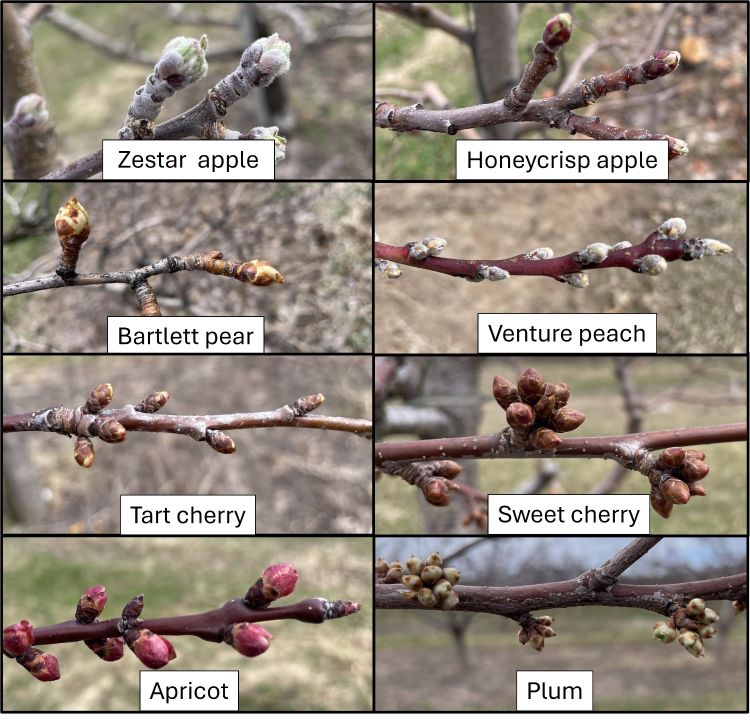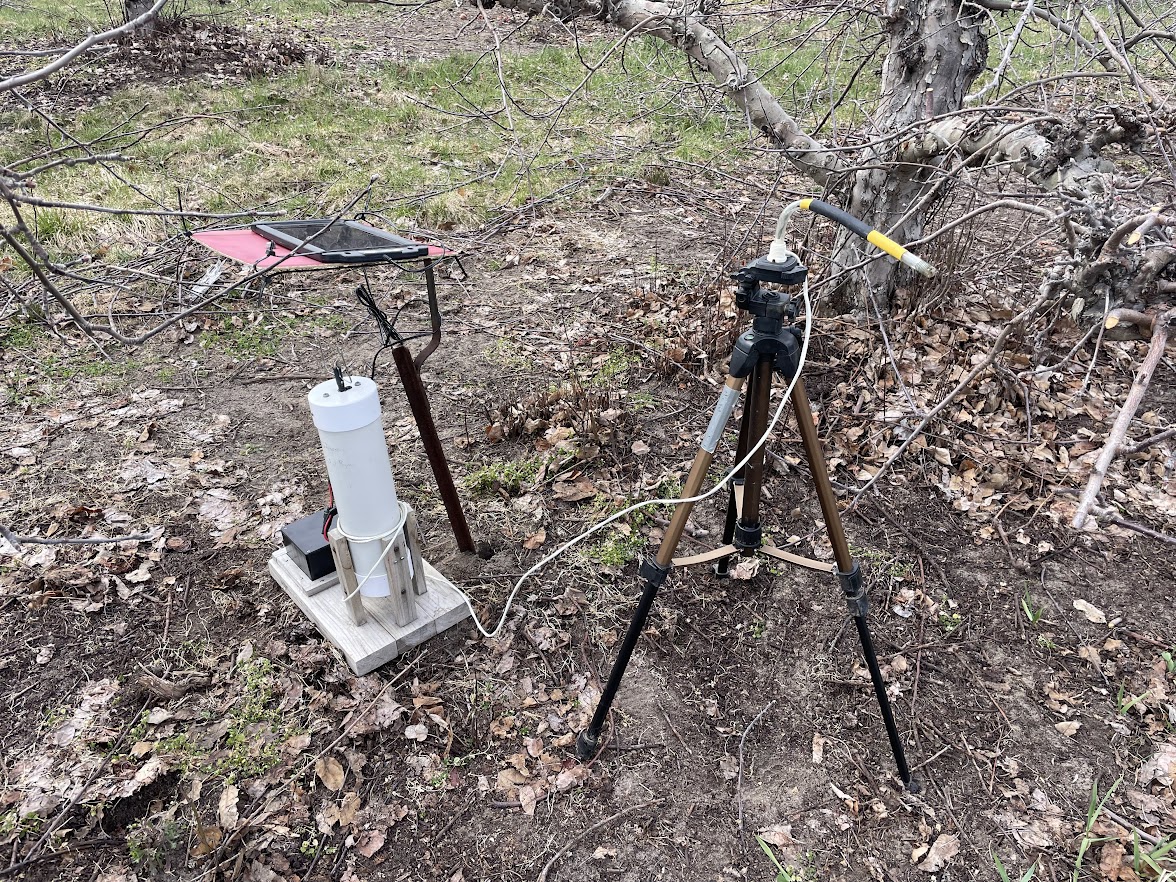West central Michigan tree fruit update – April 16, 2025
With cooler weather over the past few weeks, changes in bud phenology have been slow in the west central region. Growers have been applying dormant sprays to manage peach leaf curl and San Jose scale as needed before bud break.

Weather update
After a more normal winter with average temperatures below freezing and consistent snow cover, March was cooler than normal, which kept trees dormant. Fluctuating temperatures are expected this week in Hart, Michigan, with highs ranging from the 40s to 60s and lows around freezing and into the low 40s. For Sparta, Michigan, high temperatures will range from the 40s to the low 70s and low temperatures will range from around freezing to the low 50s.
With a few days of warmer temperatures on Thursday and Friday this week, April 17 and 18, some changes in bud development are expected. As temperatures cool down again into the weekend and into next week, changes in phenology are expected to be slow. Based on the Hart Enviroweather station, growing degree days (GDD) increased for GGD42 by about 30 units over the last week and only 10 units for GDD50. As of April 15, 144 GDD42 and 50 GDD50 are reported for Hart in Enviroweather, and 191 GDD42 and 77 GDD50 are reported for Sparta (20m tower)
On April 15, storms brought light rain across the region with 0.24 inches recorded in Hart and 0.03 inches recorded at the Sparta Enviroweather station. Another storm is predicted to bring rain on April 18 this week. With April showers and fluctuating spring temperatures, continue to monitor weather and soil conditions to best complete orchard tasks such as applying dormant sprays, pulling out old orchard blocks, finishing dormant pruning and planting new trees.
Weather data was gathered from Michigan State University (MSU) Enviroweather.
Watch a weather update from Jeff Andresen, MSU climatologist.
More information and reports on normal weather conditions and departures from normal can be found on the NOAA Climate Prediction Center website, NOAA U.S. Climate Normals website, NOAA Climate Normals Quick Access Page (which may be searched by region) and Midwest Regional Climate Center website.
Crop update
At warmer sites in Oceana County, some bud development is occurring, but the movement is slow (Figure 1). Bud development is spread out more this year between the regions than last year. Buds are at the swell stage further north in Manistee County. Some apple varieties are at silver tip or green tip in Oceana County and in some parts of Mason County. Phenology is more advanced in Sparta with green tissue showing.
Apple varieties in Oceana County range from silver tip to green tip. Early varieties such as Zestar and Idared are at green tip and even Honeycrisp and SweeTango buds have some green tissue pushing out at the tip of the bud. As a reminder, green tip in apple has historically been at 127 GDD base 42 degrees Fahrenheit for McIntosh based on over 30 years of observation from Sparta. Other apple varieties will be ahead or behind McIntosh.
Tart and sweet cherry bud range are at bud swell. If you have not been able to get out in the field yet, there is still time to apply dormant or delayed dormant applications of oil or copper sprays to manage bacterial canker and early pests such as mites or scale.
Peaches are showing signs of swelling and side green in Hart. If you have not already applied a spray for peach leaf curl, an application for final spring dormant sprays using copper products for managing peach leaf curl and bacterial canker is warranted in the next week.
Some plums are at bud swell and side green. Apricots are at the red calyx stage.
Pear varieties are at bud swell. Dormant applications of oil can still be applied to help suppress psylla populations.
Pest and disease update
With warmer conditions, pest and disease activity will begin shortly in west central Michigan orchards. Pear psylla eggs were observed in Bartlett pear at the West Central Michigan Research and Extension Center on April 14. San Jose scale was also observed this week on stone fruit and apple. Check out this Michigan State University Extension article on early season reminders for application timings for dormant and delayed dormant fruit sprays.
I will be regularly monitoring common orchard pests and apple scab infections periods over the coming weeks in Oceana County. Apple scab spore trapping equipment was put up in a commercial apple orchard in Oceana County this week (Figure 2). During the rain event that occurred April 15, three spores per rod were trapped. The Enviroweather apple scab model predicted that some spores were released, but there were not enough wetting hours to get infection. The average temperature for Hart was 36 F, and 48 wetting hours needed for infection at that temperature according to the Mills table. There were only 9 hours of wetness reported in Enviroweather, so spores did not have enough time to grow and infect leaf tissue.

Amy Irish-Brown with Valent USA will also be monitoring apple scab spores in Sparta and provided the following information on apple scab: Spore rod monitoring equipment is up and running in a commercial McIntosh block located nearby the Sparta MSU Enviroweather station. For the rain event on April 9, there was an average of 44 spores per rod caught—a higher number than expected. For the rain event on April 15, an average of one spore per rod was found. It was still raining when checked again at 11 a.m., but there is not expected to be many more added. Neither wetting event was an infection.
The next rain event forecasted for April 17-18 has temperatures in the upper 60s with daytime thunderstorms. We should expect a decent number of spores to be released and enough green showing to give us the potential for the first primary scab infection for the Ridge for 2025. Time to get those first fungicides on if you haven’t already.
The trapline at the Trevor Nichols Research Center in Fennville, Michigan, trapped an average of 0.6 adult green fruitworm this week, but green fruitworm is not a major pest in our area.
If you have not applied dormant sprays such as oil or copper, you should do so shortly.
Pests to start thinking about include:
- Black stem borer
- Green fruitworm
- Pear psylla
- Redbanded leafroller
- Spotted tentiform leafminer
- Obliquebanded leafroller
- Climbing cutworms
- San Jose scale
- European red mite
For more information about regional reports, please visit the Michigan State University Extension website.
This work is supported by the Crop Protection and Pest Management Program [grant no 2024-70006-43569] from the USDA National Institute of Food and Agriculture. Any opinions, findings, conclusions, or recommendations expressed in this publication are those of the author(s) and do not necessarily reflect the view of the U.S. Department of Agriculture.



 Print
Print Email
Email
